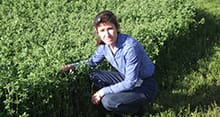 Sheep producers could significantly increase lamb weaning percentages from autumn-joined ewes by having them graze lucerne during joining.
Sheep producers could significantly increase lamb weaning percentages from autumn-joined ewes by having them graze lucerne during joining.
This new research finding is in contrast with the traditional belief that diets high in protein or nitrogen and energy could lead to embryo mortality.
Results from a recent MLA-funded project show flushing naturally cycling Merino ewes by grazing lucerne pasture seven days before joining and for the first seven days of joining lifted the number of lambs marked by 19%.
Researcher Dr Susan Robertson, of the Graham Centre for Agricultural Innovation, Wagga Wagga, NSW, said the study was prompted by industry concern regarding the potential fertility impact of grazing of ewes on lucerne prior to joining.
“We have been advocating for flushing with lucerne as it is cheaper than feeding lupins and it appears to have a better, more consistent response but we wanted to confirm these results and whether grazing lucerne throughout joining would have an impact on embryo mortality, “ Susan said.
In the grazing trial, lamb marking percentages increased from 96% to 115% when the ewes grazed lucerne for seven days before joining and to day seven of joining, compared with grazing dead annual pasture.
The results also showed ewes could graze lucerne throughout joining without any reduction in fertility or lambs marked (114%).
Management recommendations from the research include:
- For autumn-joined ewes that are naturally cycling, flushing on lucerne from seven days before joining and for the first seven days of joining is an effective method of increasing the number of lambs marked.
- Grazing ewes on lucerne throughout the whole joining period will not affect embryo mortality. Where lucerne is a limited resource, ewes only need to graze lucerne for 14 days to achieve a significant increase in lambing rates.
- The timing for spring-joined flocks where ewes are not cycling is to target the peak mating time, but it will not matter if the ewes graze on lucerne throughout joining.
- Response in ovulation rate is dependent on the quantity and quality of the lucerne.
- The pasture needs to be leafy, green lucerne.
- Twin lamb survival rates must be high to reap the benefits of flushing on lucerne. Producers adopting this practice need to consider the higher nutritional requirements of twin-bearing ewes, and their management during lambing, to optimise lamb survival.
- Do not graze lucerne if it is heavily infected with aphids, fungus or disease as this will reduce ovulation rates in ewes.
- Results from a pen study run at the same time as the grazing trial showed feeding more than maintenance quantities of fresh lucerne to artificially inseminated (AI) ewes increased embryo mortality, reducing the number of ewes carrying twins.
“The optimal nutritional management can be expected to vary in artificial situations, but we recommend producers with AI ewes only graze lucerne at maintenance levels,” Susan said.
Further research is required to evaluate different feeding strategies for both AI ewes and naturally cycling ewes.
Source: Meat & Livestock Australia

I’m trying to get a home-bred ram set-up happening using artificial insemination south of Longreach. Last November we had dreadful pasture conditions and the ewes were fed 200gms of lucerne per day plus cotton seed and faba beans to try to keep nutrition ok. Not a success..35 percent AI result. All the ewes and lambs survived. Seemed to AI cycle ok, 80%. How much lucerne (the only green feed) do we need to get a better result next time? Twice as much? 4x?
We joined our Merino rams to Merino ewes in March when we had a good stand of lucerne and dry pasture. The result when we scanned them was an unprecedented number of twins (50 percent) triplets (25pc) singles (25pc). Brendan Robertson who did the scanning had not seen such a high percentage of triplets before. The only thing we can put it down to was the high percentage of lucerne in the pasture. We had great difficulty in keeping the tripleting ewes alive and lost 25pc of them and picked up about 100pc of dead lambs. Then we did post mortems on three ewes. The lambs weighed 4kg, their stomachs were empty and they were to weak to stand up. We have learnt a lot from the experience! I hope you find this interesting.